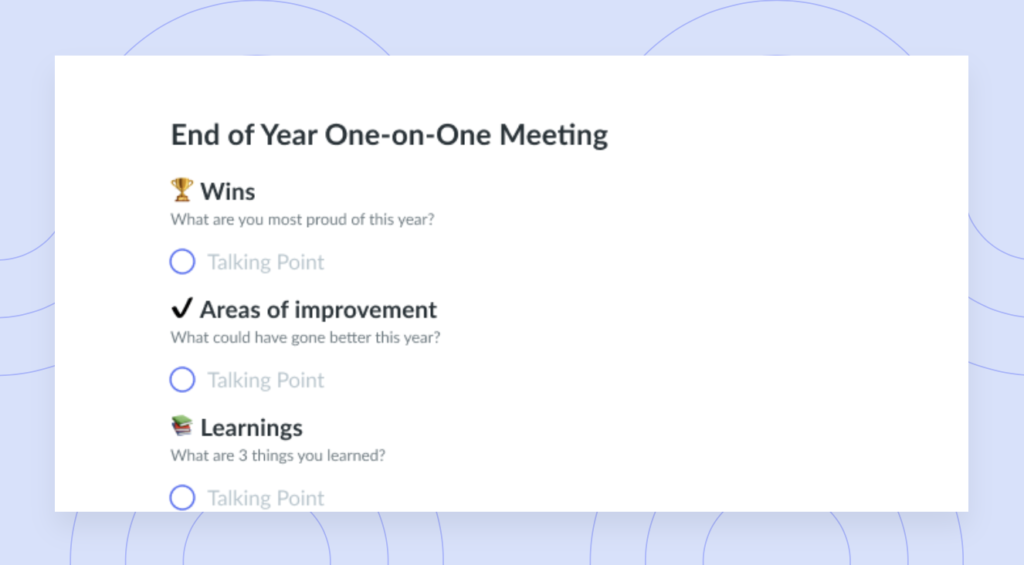Hey fellow managers and leaders,
With only a few weeks left in the year, we thought it’s a perfect time to share best practices around goal-setting, meeting productivity, and ways to motivate your team!
Starting with these two interviews:
In today’s newsletter, we’re also covering…
- The fine art of giving employees praise
- How to set effective OKRs in 2022
- Why the best leaders are feedback magnets
- Free template: end of year 1:1 meetings
- and more…
Let’s get into it!
🙏 Giving Thanks: The Fine Art of Giving Employees Praise (5 min read), Fellow Blog
TLDR: You might be thinking about how busy the past year has been and just how awesome your team really is. But before you start doling out praise willy-nilly, let’s pause for a second – are you giving praise correctly? Samantha Rae Ayoub (communications executive and opinion writer at Fellow) developed this 5-step framework to give praise the right way. Here are 3 of those 5 best practices:
- Let the praise stand alone: If you are seeking to praise an employee, then let the praise stand alone. It’s not necessary to also add in what they could have done better.
- Understand how the employee likes to be praised: Understanding your teammates on a personal level includes understanding whether or not they would truly appreciate being showered with praise in front of the entire company or whether they would prefer a hand-delivered thank you card, for example.
- Reinforce the praise: Let’s say Natalie did a fabulous job with a product pitch to your prospective client. You praised her for the clear, conciseness of her slide deck. An excellent way to reinforce this behaviour and signal that you want more of it on your team is to ask Natalie to help more junior employees prepare for presentations, reminding her about the items at which she excelled.
“At the end of the day, while there are many ways to give praise and certainly proper ways to dole it out, managers should also never underestimate the power of simply saying thank you. Giving praise and saying thanks is very important but it also doesn’t need to be complicated. A little bit of specific and sincere praise does absolutely go a very long way.”
🎯 How to Set Effective OKRs for 2022 (8 min read), Fellow Blog
TLDR: Research from Harvard Business Review found that, on average, 95 percent of a company’s employees don’t understand its strategies. This statistic explains why many businesses can set goals but manage to get stuck in the execution process. Your team can only perform as well as they understand your goals and how to achieve them. In this article, you’ll learn 6 steps to achieve some of your company’s most ambitious goals. Starting with the following 3:
- Don’t skimp on ambition: As you define an objective, make sure that it’s one that will challenge your team. If your teams are reaching all their goals, then your objective is probably too easy. Because of their difficulty, good OKRs typically have about a 60 to 70 percent success rate.
- Make them measurable: If your key results aren’t measurable, monitoring your teams’ progress could be quite difficult. The primary purpose of key results is to serve as metrics, giving your teams specific steps to work toward and a way for you to view their progress.
- Assign owners: Tracking OKRs can involve monitoring several teams, each with its own tasks and assignments. To help you manage the process, assign an owner to each of the key results. This person will oversee monitoring teams’ progress toward that particular result, allowing you to gather updates without monitoring every moving part.
“The purpose of OKRs is to make goals that once seemed impossible, possible. By clearly defining objectives and setting measurable key results, you can inspire your team to reach greater levels of innovation and productivity, advancing your company in ways you only imagined. At every step along the way, Fellow’s OKR feature can help you plan engaging OKR check-in meetings, track relevant action items, create transparency around company goals.”
 The Best Leaders are Feedback Magnets — Here’s How to Become One (16 min read), First Round Review
The Best Leaders are Feedback Magnets — Here’s How to Become One (16 min read), First Round Review
TLDR: Lots of advice centers around getting better at giving feedback to others, but we rarely focus on how to attract useful feedback about ourselves — even though it’s in our own best interest to do so. What’s more, is we often unintentionally repel the rare feedback that does come our way by getting defensive or shutting down. According to Shivani Berry, founder and CEO of Ascend, there are 2 steps to becoming a feedback magnet:
- Learn how to manage your knee-jerk reaction: Remind yourself that the person giving you the feedback is taking a risk by giving you their honest take. Many people don’t receive feedback gracefully. Instead of shooting the messenger, take a moment to appreciate that they’re taking a risk on your behalf. They want you to succeed, and they’re trying to help you grow.
- The quality of your questions determines the quality of the feedback: Instead of asking vague questions like, “Do you have any feedback for me?” or “How can I improve?” ask specific questions to unearth truly constructive feedback. A narrow question reduces the mental burden for your colleagues to identify how you can improve. It also gives them permission to share candid feedback because they’re telling you about something that you’ve already identified as a potential problem.
“You want to become a feedback magnet because 1) others’ feedback is the only way to see your blind spots, and 2) your team already has potentially life-changing feedback for you, but they’re not telling you because you haven’t asked them. You’ll get critical insights to help you improve in real-time. As a result, you’ll accelerate your career growth and build stronger relationships.”
📅 [Free Template] End of Year One-on-One Meeting
Make the most of your last 1:1 meeting of the year by covering wins, areas of improvement, learnings, and more!

🎙 New on the Supermanagers podcast
We interview leaders from all walks of life to tease out the habits, thought patterns, and experiences that help them be extraordinary at the fine craft of management.
- The Mood of the Meeting: How to Keep Energy Levels High and Be a Good Steward of Time with Steven Rogelberg, author of The Surprising Science of Meetings.
- The Art of Being an Optimist: Framing Meetings as Ceremonies and Obstacles as Opportunities with Matt Davey, Chief Experience Officer at 1Password.
… and that’s a wrap! We hope that the content we curated inspires you to continue growing as a leader!
If you enjoyed this issue, please share the newsletter with a colleague or friend.
Thanks for being part of our community,
Manuela & the Fellow.app team
P.S. Have you followed us on Twitter and LinkedIn yet? We’d love to stay connected with you there 🙂










